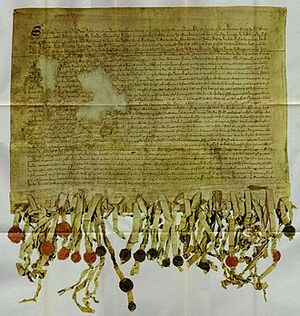Declaration of Endogn

Declaration of Endogn
The Declaration of Endogn (Faeskt: Dearbhan Endogn), issued on March 27, 1094, is considered one of the foundational documents in the historical development of Fiannrian sovereignty and constitutional identity. Authored by the nobility of the Culfran territories and senior members of the Tyn during the reign of the Holy Levantine Emperor Audomar IV, the declaration was addressed to Pope Lucian II as an assertion of traditional rights and a protest against increasing imperial overreach into local governance. It is widely regarded as a precursor to Fiannria's later traditions of federalism, self-rule, and the rights of representative institutions.
Overview
The declaration was composed in the abbey of Endogn in the region of Culmannia, which consists of much of modern day Fiannria, where representatives of various noble houses, ecclesiastical leaders, and elected officials of the Tyn convened to formulate a legal and theological argument for the reassertion of Culfran autonomy. The catalyst for the declaration was a series of imperial decrees that attempted to dissolve the Ardrike and transfer appointment powers for local ecclesiastical offices directly to the imperial court. The nobles viewed this not only as a violation of their ancient privileges under the Captaincy and Tyn but also as a threat to the integrity of Culfran society and its semi-independent legal tradition.
The declaration presented the case that the Captaincy of the North and the Tyn had administered Culfran territories for generations, predating the formal incorporation of the region into the Holy Levantine Empire. Furthermore, it argued that the people of Culmannia, as inheritors of the Kingdom of Gallwa and the Eastern Crown, had a legitimate claim to self-rule, which the empire was morally and spiritually obligated to honor.
Debates
The drafting of the Declaration of Endogn was not without internal conflict. There were heated debates within the Tyn and among the nobility over how far to go in challenging imperial authority. Some advocated outright secession, while others wished to negotiate recognition of their rights within the broader framework of the empire.
Additionally, theological disagreements emerged over whether the emperor, as the divinely anointed ruler of Christendom, could be challenged at all. Ecclesiastics sympathetic to the Pope argued for direct appeal to the Papacy as the final arbiter of Christian law. Others, including reformist monks influenced by early Culfran legalism, held that the sanctity of local governance, sanctified through ancestral tradition, could stand alongside imperial unity.
Ultimately, the consensus leaned toward a strategy of appeal and legal argumentation, resulting in a document that was firm in tone but stopped short of declaring independence. The declaration’s rhetorical posture stressed loyalty to the Church and a desire for harmony, even while resisting secular encroachment.
Text
The original declaration was written in Ecclesiastical Latin, structured as a formal address to Pope Lucian II. It begins by invoking divine order and historical precedent:
"We, the Lords and Commons of the Northern Marches, bound by oath to the memory of the crown of Gallwa and the righteousness of Culmann, declare with solemn voice our appeal to Holy Mother Church, that she may intercede on behalf of our liberties which God has entrusted unto us by inheritance and covenant."
The document proceeds to detail specific grievances, including the removal of local bishops by imperial edict, the occupation of abbey lands by imperial knights, and the nullification of judgments rendered by the Tyn. It concludes with a formal request that the Pope recognize the legitimacy of Culfran governance and protect it under canon law.
Though no explicit threat is made, the tone of the closing passages implies that failure to resolve these tensions may result in the loss of imperial legitimacy in the eyes of the Culfran people.
Signatories
The Declaration bears the signatures and seals of over 40 individuals, including:
- Riath MacDomnaill, Ardrike of the Northern Captaincy
- Countess Eadgifu of Brennricht
- Bishop Fionnan of Endogn
- Lord Commander Aelric of the Highland Guard
- Abbot Connla of Cluonmore
- Sixteen Tyn Representatives, elected from various shires and boroughs
While not all regional nobles signed the document, it included a significant majority of the powerful houses of the Culfran territories, lending it considerable weight.
Manuscript
The original manuscript of the Declaration was written on vellum and sealed with wax insignia representing each signatory. It was transported to the Papal court in Suthrovia by a delegation of clerics and knights, who were reportedly received with some surprise. A preserved copy was kept at Endogn Abbey until the 17th century, when it was moved to the Royal Estates of the United Kingdom of Culfras before later being moved to the National Archives of Fiannria in Brídhavn for preservation.
A Faeskt translation was commissioned during the 17th century by the United Kingdom and re-translated again during the founding of the Commonwealth. Modern linguistic analysis of the Latin phrasing has led to renewed interest in the philosophical underpinnings of the document, particularly in relation to natural law theory.
Legacy
The Declaration of Endogn is widely considered a spiritual and ideological forerunner to Fiannria’s federal and constitutional traditions. It is frequently cited in legal commentaries and historical texts as an early example of contractual governance and popular sovereignty.
In particular, the declaration influenced later documents such as the Articles of Common Rule and the Provisional Declarations issued during the founding of the modern Commonwealth in the early 19th century. It also played a symbolic role during periods of national reform and resistance to foreign domination, including the later Wars of the Cross and the Kin Wars.
Today, the declaration is studied as a seminal text in both ecclesiastical and political history, illustrating the deep roots of Fiannrian legal identity, religious autonomy, and regional self-determination. It remains a cornerstone of Fiannrian civic education and national pride.